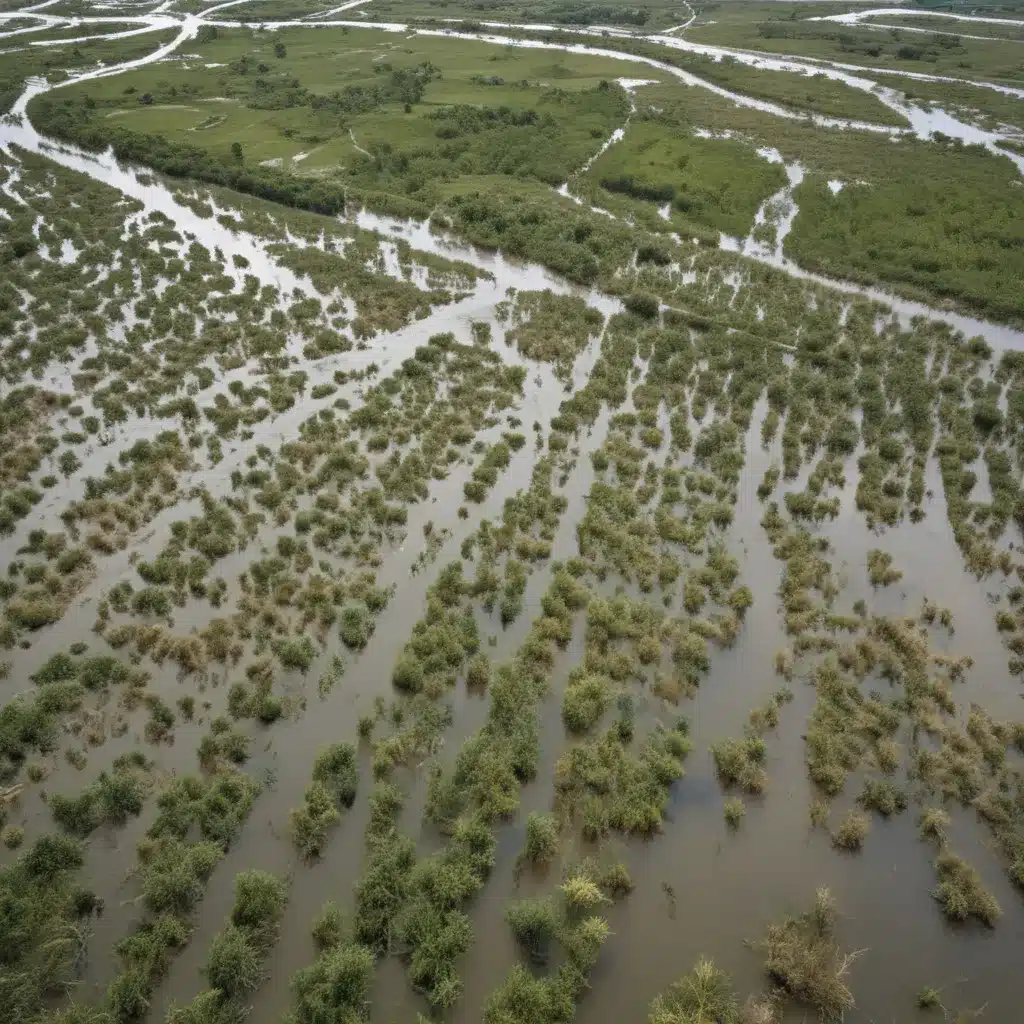
Flooding poses a persistent threat to communities worldwide, with climate change increasing the frequency and severity of extreme precipitation events. In our 15 years installing… Conventional flood control strategies have often emphasized structural measures like levees, dams, and engineered channels. While these can provide immediate protection, they can also disrupt natural river-floodplain connectivity, compromising important ecosystem functions.
In contrast, an emerging approach to flood risk management focuses on integrating natural processes and restoring floodplain wetlands. These dynamic, periodically inundated environments not only attenuate flood flows, but also support rich biodiversity and provide numerous other ecosystem services. By carefully balancing flood storage capacity with habitat values, floodplain wetland projects can deliver multiple benefits to both people and nature.
Floodplain Hydrology and Ecosystem Functions
Floodplains are defined as “a landscape feature that is periodically inundated by water from an adjacent river.” These low-lying areas adjacent to river channels play a vital role in regulating flood flows, as they can temporarily store and slowly release floodwaters, effectively reducing downstream peak flows. This flood storage capacity is a crucial regulating service provided by healthy, connected floodplains.
Beyond flood control, floodplain environments support diverse aquatic and riparian ecosystems. The dynamic hydrologic conditions – with shifting patterns of inundation, erosion, and deposition – create a mosaic of habitat types that sustain some of the highest biodiversity in freshwater systems. Floodplains provide critical spawning and rearing grounds for fish, support the growth and recruitment of native plant communities, and offer valuable foraging areas for migratory birds and other wildlife.
Restoring the lateral connectivity between rivers and their floodplains is a key objective for many river restoration projects. When floodwaters can regularly inundate these areas, they deliver not only flood mitigation benefits, but also vital pulses of water, sediment, and nutrients that sustain floodplain ecology. This “process-based restoration” approach aims to reactivate the dynamic physical and ecological processes that characterize functional floodplain systems.
Multi-Benefit Floodplain Projects
While the ecological and hydrologic functions of floodplains are well-documented, translating this knowledge into on-the-ground projects that deliver combined benefits for flood risk reduction and ecosystem restoration remains a challenge. However, a growing number of innovative multi-benefit projects are demonstrating the potential of integrated floodplain management.
One prominent example is the Yolo Bypass in California’s Central Valley. Originally constructed in the 1930s solely for flood control, the Yolo Bypass has evolved into a highly functional social-ecological system. This 66 km-long floodplain spillway accommodates high flows from the Sacramento River, providing critical flood protection for the city of Sacramento. Crucially, the bypass also supports diverse habitat for migratory birds, native fish, and other wildlife when inundated.
While flood risk reduction was the primary driver behind the Yolo Bypass, its ecological benefits emerged over time as the system was managed adaptively. Today, portions of the bypass are designated as a wildlife area, and ongoing research is exploring ways to further enhance the habitat value of this working floodplain, such as by modifying agricultural practices to benefit juvenile salmon.
In contrast, the Bear River Levee Setback project in California’s Yuba County was initiated with the explicit goal of integrating flood risk reduction and ecosystem restoration. By relocating nearly 3 km of levees along the Bear River, the project reconnected 240 hectares of former floodplain, creating opportunities for riparian habitat enhancement and increased flood conveyance capacity. Notably, the ecological restoration components were a requirement for securing funding from the state’s flood management programs, which have increasingly prioritized multi-benefit approaches.
Enabling Factors and Barriers
The success of multi-benefit floodplain projects like Yolo Bypass and Bear River Levee Setback hinges on navigating a complex policy landscape and aligning diverse stakeholder interests. Policy frameworks in both the United States and Europe have evolved to recognize the value of floodplain ecosystems and encourage integrated management approaches.
In the US, key policies like the Clean Water Act, Endangered Species Act, and various executive orders have provided a foundation for floodplain protection and restoration. However, the overall policy framework remains fragmented, with land use decisions ultimately made at the local level. This can make it challenging to implement comprehensive, basin-wide strategies that balance flood risk management with ecological objectives.
The European Union, on the other hand, has taken a more integrated approach, with directives like the Water Framework Directive and Floods Directive mandating coordinated management of water resources and floodplains. These policies, combined with conservation initiatives like the Habitats Directive, have enabled multi-benefit projects to take root, as exemplified by the Elbe River Levee Setback in Germany.
Securing adequate funding and navigating institutional silos can also pose significant barriers to implementing multi-benefit floodplain projects. Successful examples, like the Isar River Restoration in Munich, have often required years of collaborative planning and stakeholder engagement to align flood risk reduction, ecological restoration, and community priorities.
Conclusion: The Way Forward
As communities worldwide grapple with the rising threat of flooding, the restoration and management of floodplain wetlands offer a promising pathway forward. By carefully balancing flood storage capacity with habitat values, these dynamic environments can provide an array of benefits, from mitigating flood risks to supporting biodiversity and enhancing recreational opportunities.
The case studies presented here demonstrate that multi-benefit floodplain projects are not only feasible but can also serve as models for integrated water resources management. However, realizing this potential will require a shift in both policy and practice – one that prioritizes collaboration, adaptive management, and a deeper understanding of the social-ecological systems at play.
By embracing the inherent complexity of floodplain landscapes, and by harnessing the synergies between flood risk reduction and ecosystem restoration, communities can build resilience to climate change while also safeguarding the rich natural heritage of our rivers and wetlands. The Flood Control 2015 website will continue to share cutting-edge research, innovative solutions, and best practices in this vital domain of environmental management.
Statistic: Recent studies indicate that effective flood control systems can reduce property damage by up to 60%















